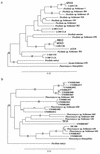Screening of a fosmid library of marine environmental genomic DNA fragments reveals four clones related to members of the order Planctomycetales
- PMID: 9687477
- PMCID: PMC106819
- DOI: 10.1128/AEM.64.8.3075-3078.1998
Screening of a fosmid library of marine environmental genomic DNA fragments reveals four clones related to members of the order Planctomycetales
Abstract
A fosmid library with inserts containing approximately 40 kb of marine bacterial DNA (J. L. Stein, T. L. Marsh, K. Y. Wu, H. Shizuya, and E. F. DeLong, J. Bacteriol. 178:591-599, 1996) yielded four clones with 16S rRNA genes from the order Planctomycetales. Three of the clones belong to the Pirellula group and one clone belongs to the Planctomyces group, based on phylogenetic and signature nucleotide analyses of full-length 16S rRNA genes. Sequence analysis of the ends of the genes revealed a consistent mismatch in a widely used bacterium-specific 16S rRNA PCR amplification priming site (27F), which has also been reported in some thermophiles and spirochetes.
Figures


References
-
- Achenbach-Richter L, Gupta R, Stetter K O, Woese C R. Were the original eubacteria thermophiles? Syst Appl Microbiol. 1992;9:34–39. - PubMed
-
- Christen, R. 1997. Personal communication.
-
- Davey M E, Wood W A, Key R, Nakamura K, Stahl D A. Isolation of three species of Geotoga and Petrotoga: two new genera, representing a new lineage in the bacterial line of descent distantly related to the “Thermotogales.”. Syst Appl Microbiol. 1993;16:191–200.
-
- Defosse D L, Johnson R C, Paster B J, Dewhirst F E, Fraser G J. Brevinema andersonii gen. nov., sp. nov., an infectious spirochete isolated from the short-tailed shrew (Blarina brevicauda) and the white-footed mouse (Peromyscus leucopus) Int J Syst Bacteriol. 1995;45:78–84. - PubMed
Publication types
MeSH terms
Substances
Associated data
- Actions
- Actions
- Actions
- Actions
LinkOut - more resources
Full Text Sources
Other Literature Sources
Molecular Biology Databases

